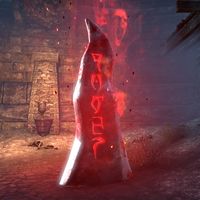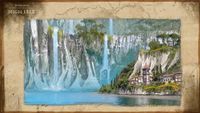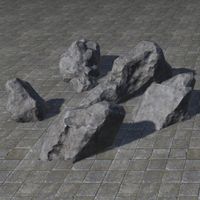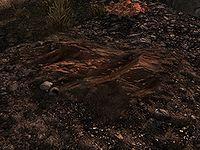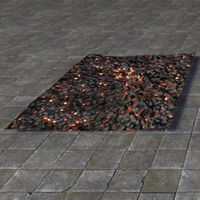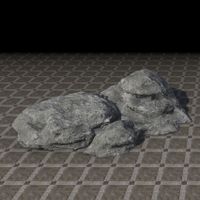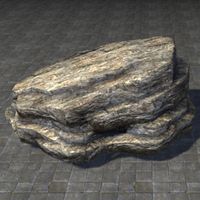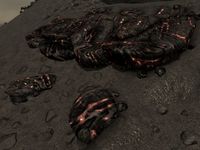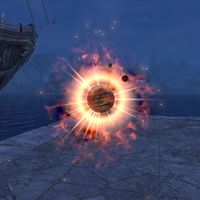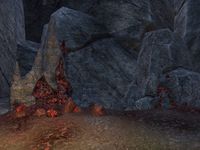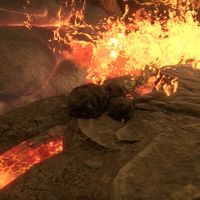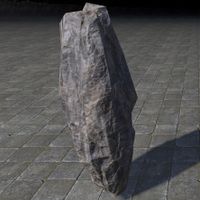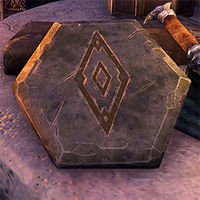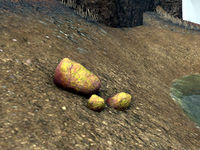Lore:Other Minerals
Agonymium[edit]
Agonymium is a type of stone that possesses the power to consume mortal misery. It is usually grey in color, but glows red when infused with the screams of mortal agony. The stone can become dormant and lose this ability.[1] Concentrating on a fragment of agonymium can cause a mortal to temporarily discorporate, splitting into slivers of individualized torment.[2] Pillars of agonymium engraved with Daedric writing were used extensively throughout the Dread Cellar.[3]
Alabaster[edit]
Alabaster is a white stone. Cliff faces made of alabaster can be found in High Isle.[4][UOL 1] The walls of the eponymous settlement of Alabaster are said to be made from it, as are some Ayleid ruins.[5][6] The Resolution of Zenithar is in possession of a hundred-foot tall obelisk made of alabaster that stands above all as a symbol welcoming commerce, and is said to be so finely polished that it reflected back shades of the sea and sky.[UOL 2]
Ammonite[edit]
Ammonites (also known as Eltheric Ammonites) are extinct aquatic mollusks once native to the Eltheric Ocean and known only for the beautiful shells they left behind. Although the true origin of these shells is unknown, the consensus among naturalists is that ammonites predate even the oldest of Merethic Era ruins.
Ammonites are most commonly harvested for use by mages and druids due to the fact that they contain stores of raw magicka. The capacity varies depending on the shell, with some only holding trace amounts of magicka and others holding nearly as much as a lesser-grade soul gem. However, ammonites cannot be recharged and suffer from arcane decay, losing potency within a month of being harvested.
Basalt[edit]
Basalt is a heavy, coarse stone known to have formed in hexagonal pillars on Solstheim.[7][8][UOL 3] Basalt is often considered to be unsuitable for delicate stonework, but early Dunmer are known to have crafted with it regardless,[9] particularly in the walls of buildings in Vivec City.[10] The Heartlands of Cyrodiil are noted for their basalt; basalt taken from the Niben River is particularly sturdy.[11]
Bezoar[edit]
A Bezoar stone is a hardened mass formed in animal stomachs. Bezoars find use in a variety of settings, including alchemy, medicine, craftwork and rituals.
Bismite[edit]
Bismite is an iridescent mineral made from bismuth. Pure bismuth can be extracted from it. Bismite has harmonic properties, and similarly to bismuth it occurs naturally in large quantities on the isle of Solstice south of the mainland Black Marsh. Its hollow nature gives it musical qualities, so the Argonians of the isle used it, or the bismuth obtained from it, to make music boxes.
Bismuth[edit]
Bismuth is a crystalline metal with an iridescent appearance that can be found in trace amounts on the Tamriel continent. This is contrast to the large deposits that can be found on the island of Solstice in the Southern Sea. The formations on Solstice can grow to an immense size, which suggests the environment for their growth is quite unique, and these formations can be found in the mines and caverns of the island.
Chalk[edit]
Chalk is a soft white porous rock, that has a variety of uses, such a form of writing or drawing implement. It can also be dyed a variety of colors.[12] Unscrupulous alchemists or bakers may adulterate their goods by adding ground chalk as a filler.[13][14] Chalk also has uses in certain magical rituals such as when preparing a ritual space.[15][16]
Some cosmetics make use of chalk, for example the Bright-Throats were known to have used chalk as dye for their tribe's body paint.[17][18] Chalk can also be used a powder foundation for facial cosmetics, such as with the Khajiit in Pellitine.[19] In the Second Era, some Thieves Guilds used fine chalk when crafting their armor and weapons.[20]
Charcoal[edit]
Chert[edit]
Chert is a type of rock. It was mined by Imperials.
Kingscrest Cavern, located north of Cheydinhal in the Jerral Mountains, was a known source of chert and flint, occasionally utilized by the vassals of House Tharn. By the year 2E 582, it had been abandoned and taken over by wild creatures, a state it remained in during 3E 433. A specific part of the cavern was referred to as the Chert Galleries.
Clay[edit]
Clay is a mud-like substance commonly used in pottery, porcelain,[21] and bricks.[22] It is sometimes used for skincare and to preserve mudcrabs.[23] The Orsimer are known to use it in their paints.[24] It is also sometimes used for chips for use in games.[25] In ancient times, the Argonians used clay for tablets used to inscribe Jel pictograms.[26]
Coal[edit]
Coal is brownish-black rock that is primarily used as fuel.[27] It is also used as a component in black body paint.[28] Anthracite is a variety of coal.[29] Coals are used in a Reachfolk ritual of ember dance.[30] Cinder-Heart Clan uses them in their version of Briarheart ritual.[31]
Coprolite[edit]
Coprolite is a type of fossilized excrement or dung, often found in the form of solid, mineralized feces.
Vulk'esh excrement has a tendency to harden into dense, heavy, igneous chunks that bear a resemblance to slag. These chunks have potential applications.
Coral[edit]
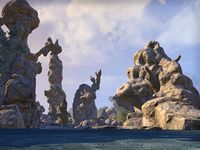
Coral is a type of aquatic rocklike structure, formed from the bones of tiny sac-animals, that comes in many different varieties.
In Sload society, it is prominently used in their architecture. Dense corals supposedly provide the entire foundation of Thras and the Coral Tower itself was made from blood-red coral before its collapse. The Sload are also said to use tangled nests of coral formations to move around, and it's even used in their armorsmithing, with different types of corals providing different advantages in battle, such as lightness or durability.
Some of the most ancient ruins of Summerset Isle are thought to have been built by the Sload and are made of coral, including the original architecture of Cloudrest. In Morrowind there is a naturally-occurring bioluminescent, and possibly sentient, coral species that grows on the lands around the Inner Sea.
Fulgurite[edit]
Fulgurite is a tube shaped rock that forms when lightning strikes sand, leaving behind a hollow structure.[32]
Gabbro[edit]
Gabbro is a type of stone.[33] It is found in Blackwood.[34]
Granite[edit]
Granite is a type of stone. The Charred Ridge is a granite mountain range that separates Stonefalls and Deshaan. The Tormented Spire is its highest peak and anchors it to the west.[35][36] When Vivec City was expanding in the mid-Second Era, a granite quarry was built in Foyada Mamaea and became the project's main source of granite. The operation closed when Red Mountain erupted a lava flowed in through the site.[37]
The mines of Markarth harvested granite and its supplies were used to build Castle Evermore's battlements.[38] The Mount Kilkreath foothills of Haafingar are made of granite.[7]:415 Granite Hill is a historical settlement in Skyrim, specifically in Falkreath Hold. The word used for "granite" in the dragon language is "Quethsegol" meaning "stone,"[39][7] or literally "Bone-of-earth."[7] Previously, Nordic stonesmiths used porphyry deposits to erect igneous rocks for architecture, but by the Second Era, it was replaced with hard-wearing granite and volcanic stone.[40]
In the middle of Auridon, just west of Skywatch is a large, white granite mountain.[41] As the range travels north, it hardens and forms the jagged promontories of the north coast. Several sites of interest, like the town of Shattered Grove, the temple ruins of Tanzelwil, and the former royal summer home in the Glister Vale are found in its vicinity.[42] The steps of Ceyatatar in Cyrodiil are made of granite and is where Pelinal Whitestrake slew the Fire-King, Hadhuul.[43]
Greywacke[edit]
Greywacke is a kind of stone. A number of greywacke stones depicting one of the three guardian constellations: the Warrior, the Thief, and the Mage were found around Tamriel during the Interregnum. Those idols made of greywacke were known as the Guardian Stones.
Grinstone[edit]
Grinstone is a yellow-toned metallic ore used to craft Grim Harlequin weapons and armors. This style was linked to the cult of Shogorath, who instructed his chamberlain, Haskill, to create a guide for those wishing to craft "Grim Harlequin" arms and armor, ensuring that the Mad God's mortal followers could uniform their equipment. As Haskill put it, this standardization directly contradicts all other cult practices and is, in itself, utterly insane. He also speculated that by the time he began compiling the notes, Sheogorath himself might have forgotten about the whole matter. The armor itself was known for its consistent motif of grinning skulls and jester faces.
Grit-rock[edit]
Grit-rock is known to have been used in sanding wooden planks.[44]
Gypsum Alabaster[edit]
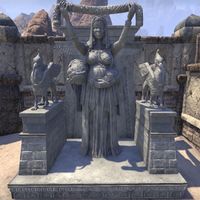
Gypsum alabaster was used extensively by the Lefthanded Elves.[45]
Heart Stone[edit]
A Heart Stone (also spelled Heartstone) is an unusual type of ore mined from deposits which appeared in Solstheim in the Fourth Era. Though deposits of them have been known to exist in the Brothers of Strife ruins in Stonefalls circa 2E 582. It is suspected that the deposits on Solstheim surfaced (or landed on the surface) during the cataclysms of the Red Year; Master Neloth of House Telvanni suspected that the material came from Red Mountain and was flung along with other materials to Solstheim during its eruption, and may continue to land on Solstheim from smaller eruptions. Even two centuries later, they still smolder with the heat of the mountain. As the molten rocks had laid next to the Heart of Lorkhan for millennia, some vestige of its power has seeped into them. Heart stones sometimes raise Ash Spawn from the bits of bone buried in the nearby ash. Through trial and error, Neloth's apprentice Talvas Fathryon learned that a stone was needed to prevent an ash guardian summoned through Conjuration from attacking the caster. The stones can also be used for enchanting purposes.
Neloth's previous apprentice, Ildari Sarothril, was killed during an experiment and brought back to life when one of these stones was grafted to her. Ildari learned that a stone could be used to prevent necromantic spells from wearing off. She used them to bolster her necromantic spells used to revive Falx Carius. Those revived with the stones in their chest felt constant pain, and had "voices" in their head, often telling them to distrust others.
Holystone[edit]
Holystone is a light pumice sometimes used to clean the decks of ships.[44]
Limestone[edit]
A common material used in the construction of buildings, limestone forms the base of most Imperial and Ayleid architecture.[46][47]
Marble[edit]
Marble possesses a strength and beauty that has been utilized in decorations and monuments for centuries.
Amber marble is often associated with Hollowjack.
Morpholith[edit]
A morpholith is a type of mineral. Common morpholiths such as soul gems can be found within nature.[48]
Quasi-crystalline morpholiths are involved in the creation of sigil stones. These exotic morpholiths occur only in pocket voids of Oblivion and cannot be mined or harvested without Daedric assistance.[48] Daedra are theorized to use enchanted chisels to excavate such exotic morpholiths.[49] Some morpholiths harvested in this manner are inherently unstable and therefore unsuitable for use as sigil stones.[50] Although unstable morpholiths cannot be used to open portals, they do have other uses in various summoning rituals.[51]
Nirncrux[edit]
Nirncrux, commonly called red brittle, shake stone, and miner's bane, is a red stone found only in Craglorn. In its raw form, it releases a poisonous gas when cracked which can cause symptoms ranging from nausea, body tremors, and disorientation to convulsions, slurred speech, memory loss and death. One theory on why Nirncrux is abundant in Craglorn is that the Nedes of the area used arcane rituals to draw it from deep within Nirn's crust. Regardless of the validity of this speculation, the Nedes learnt how to harness its ability to absorb and distribute Aetherial energy.
Ochre[edit]
Ochre is an orange clay pigment. Torval Royal Ochre, a rare and valuable pigment that comes from the aforementioned clay is found in the area of Torval.[52]
Petrified Wood[edit]
Potash[edit]
Potash is a kind of ash[53] that has many uses, particularly in Orcish culture. It is sometimes used in equipment reverent of Malacath[54] and in some traditional Orcish ware.[55] It is also known to be used in glassmaking.[53]
Pumice[edit]
Pumice is a light-weight, porous rock that can be found in volcanic areas. It is often used for its abrasive qualities, as a cleaner or to smooth other items.[56][57][44] A variety of pumice known as Night Pumice was sometimes used in crafting ebony equipment in the Second Era.[58]
- ESO (Night Pumice)
Regulus[edit]
Rubber[edit]
Rubber is an elastic material. Throughout Tamriel and beyond, rubber has found a multitude of applications across various cultures.
Sandstone[edit]
Shale[edit]
Shale is a sedimentary rock known for its fine-grained texture and ability to split into thin layers. Orichalcum is often found in brittle shale. The Bright River-Shale, a rare and gleaming stone, is often employed by the Reachfolk in their religious rituals, and it is found within the Karth River.
Schist[edit]
Schist is a type of rock used in Reachfolk craftsmanship. It found use in Reachfolk art, particularly in the crafting of idols linked to their religious beliefs, including those associated with the Daedric Prince Hircine. As of the year 2E 582, finely crafted stone idols resembling the antlers of Hircine, the Lord of the Hunt, crafted from schist by the Reachfolk and adorned with bone inlays, were discovered throughout Tamriel.
Scoria[edit]
Scoria is a type of volcanic rock formed when lava cools upon exposure to air. Though not typically favored for crafting, it holds great interest among skilled alchemists and scholars.
Skarn[edit]
Skarn is a metamorphic rock. The Druids of the Firesong Circle were known to craft their weapons and armor from volcanic rock and living skarn sourced from the Mount Firesong, their sacred site, using it for both protection and adornment. They shaped the skarn using volcanic hammers and obsidian implements.
Slate[edit]
Soapstone[edit]
Soapstone (or lipsand in Ayleidoon) is a type of soft stone, often finely carved, that is used for various purposes. It is commonly used for crafting objects such as meditation beads, replicas of structures, and idols. It can also grant an enchantment the property of poison resistance.
Spellstone[edit]
Spellstone is a magical alloy created by the great mage Shalidor. It is said that Shalidor traveled to multiple Oblivion planes, collecting crystals from at least five different realms. Through a highly perilous transmutation spell, he fused these crystals together to create an alloyed spell-focus.
Sulfur[edit]
Sulfur is a yellow mineral with a strong odor. It can be found both on Tamriel as well as in Oblivion realms such as the Deadlands.[59][60]
Tel Var Stones[edit]
Tel Var Stones are magical pieces of the White-Gold Tower that purportedly contain the essence of Creation. According to Tower Lore, scholars postulate that when the Ayleids built the White-Gold Tower, they couldn't recreate their own Zero Stone, so they settled for Tel Var Stones. It's believed the stones are imbued with vast magical power that lies dormant within. With further study, scholars believe details of the White-Gold Tower's construction could be revealed. Experimentation on powdered stones revealed that all elements of magical practice reside within them. Should the stones be destroyed, some believe that the essence of Creation within them is lost.
Tuff[edit]
Tuff is a type of rock formed from volcanic ash and fragments that have been compacted and cemented together. Red Mountain ash from its eruption could be found in tuff around Lake Rumare during the Second Era. It was used as an ingredient in an alcoholic beverage called Nirnroot Wine.
Washtongue Powder[edit]
Washtongue powder is a mineral native to the Murkmire region of the Black Marsh. It is traditionally used by local Argonians in their pottery, where it is known to aid in the firing process. While harmless to Argonians, it causes significant intestinal issues for other races. Pottery made with washtongue powder is allegedly unsuitable for storing edible products for other races unless it is coated with a specific ash-glaze made from a rare plant found on the peninsula north of Alten Meerhleel.
References[edit]
- ^ Agonymium Stone, Inert furnishing in ESO
- ^ Agonymium Stone memento in ESO
- ^ Agonymium Stones in the Dread Cellar in ESO
- ^ High Isle Concept Art
- ^ Remnants of Cyrod
- ^ Ayleid Crate description
- ^ a b c d e The Elder Scrolls V: Skyrim: Prima Official Game Guide — David Hodgson
- ^ Hand Kenro's Note
- ^ Basalt Table-Game Set Antiquity Codex entry in ESO: Greymoor
- ^ Vivec Palace art
- ^ Ayleid Blacksmithing Station Heartland Basalt Base Codex entry in ESO
- ^ Chalk Stick Set item description in ESO
- ^ The Wedding Feast: A Memoir — Naral, also known as Baretail
- ^ Thania Facian dialogue in ESO: Gold Road
- ^ Dreadhorn Shaman item description in ESO: Horns of the Reach
- ^ Practical Necromancy
- ^ Chalk and Coal Scale Skull, Chalk and Coal Skull, Chalky White Lips face markings in ESO
- ^ Bright-Throat Chalk Body and Face Tattoos item descriptions in ESO
- ^ Pellitine Snout-Powder item description in ESO
- ^ nameFineChalk
- ^ Porcelain Teapot in ESO
- ^ Mobar Mine loading screen in ESO
- ^ Crock of Packing Mud in ESO
- ^ The Red Paint
- ^ Legends of the Forest — the Sisters Glumm
- ^ Xal-Toh Tablet in ESO
- ^ Events of A Sticky Solution in ESO: Clockwork City
- ^ Painted Coal and Embers body markings in ESO
- ^ Onyx Indrik's default name in ESO
- ^ Ard Caddach's dialogue in ESO: Markarth
- ^ On the Clans of the Reach — Theopho Harvian, Imperial Scribe
- ^ Fulgurite Forger in ESO: Stonethorn
- ^ Rock, Gabbro Set, Rock, Wide Gabbro Slab, Rock, Gabbro Boulder Cluster, Rock, Gabbro Boulder in ESO
- ^ Sweetwater Cascades in ESO
- ^ Tormented Spire loading screen text in ESO
- ^ Charred Ridge loading screen text in ESO
- ^ Foyada Quarry loading screen text in ESO: Morrowind
- ^ The Improved Emperor's Guide to Tamriel: Northern Bangkorai and the Mountains — Flaccus Terentius, 2E 581
- ^ Holdings of Jarl Gjalund — Slafknir the Scribe
- ^ The Improved Emperor's Guide to Tamriel: Skyrim — Flaccus Terentius, 2E 581
- ^ The Improved Emperor's Guide to Tamriel: The Summerset Isles: Auridon — Flaccus Terentius, 2E 581
- ^ Auridon in ESO
- ^ The Song of Pelinal, v 3
- ^ a b c Coldrock Diggings loading screen text in ESO
- ^ Morwha's Blessing in ESO
- ^ Limestone in Blades
- ^ Dirty Scroll
- ^ a b Liminal Bridges — Camilonwe of Alinor
- ^ Ancient Morpholith Chisel Antiquities Codex in ESO
- ^ Unstable Morpholith pet in ESO
- ^ Unstable Morpholith fragment upgrades in ESO
- ^ Ball of Royal Ochre Mohair Yarn description in ESO
- ^ a b Cheeses of Skyrim: Whiterun, Winterhold, Eastmarch — B.
- ^ Potash in ESO
- ^ Worn Orcish Cauldron in ESO
- ^ Carved Pumice Stone item description in ESO
- ^ Pearls of Ehlnofey—Aetherquartz Prayer Beads Codex Entries in ESO
- ^ Ebony Style and the styling material Night Pumice used in ESO
- ^ Sulfur Pools in Stonefalls in ESO
- ^ Sulfur Pool item description in ESO: Deadlands
Note: The following references are considered to be unofficial sources. They are included to round off this article and may not be authoritative or conclusive.
- ^ High Isle Chapter Preview
- ^ Ted Peterson's posts in Playing Houses
- ^ EditorIDs of static objects on Solstheim in Skyrim
